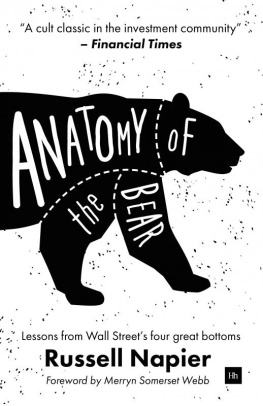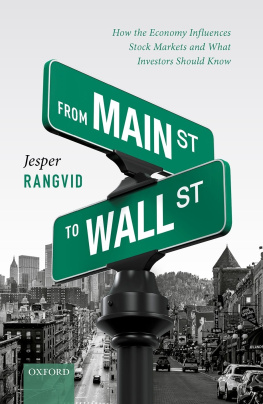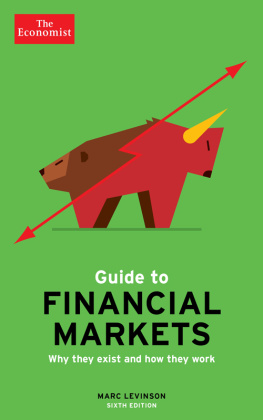Foreword by Merryn Somerset Webb
Russell Napier is not a crowd pleaser. There are no predictions of Dow 10,000 in this book. However, he is a fabulous historian, educator and, as his introductions to past editions of this book suggest, forecaster. The last preface in 2009 told us that valuations were low enough and deflation exaggerated enough that there was a substantial bear market rally ahead. There was. The question then and the one Russell asks in his new preface is whether the huge rise in most western markets since has been more than a rally. Was 2009 a great bottom and the market we are all investing in today a perfectly safe long-term bull market?
Russells answer to this? It is not.
It was impossible for me at least in 2009 to imagine the monetary environment we live with now. I couldnt imagine interest rates in the UK staying at their lowest level in 300 years for 27 quarters and counting. I couldnt really imagine negative interest rates or endless QE. It wasnt immediately obvious that super-loose monetary policy would poison our economies with capital misallocation and huge over-supply of almost everything. And I dont think it ever occurred to me that our central bankers would look at what is clearly an asset-price bubble created by their own policies and put it about that those same policies are working just fine. So well, in fact, that a bit more of them cant (surely!) do any harm.
It was also all but impossible for most of us to imagine how all-powerful investors would come to see the central banks as being. In the years since 2008 our elected governments have effectively handed over financial crisis management to their unelected appointees at the Fed, the Bank of the England and the ECB and while the rational will think that this isnt really a good thing (the most important thing to watch in a country should not be the minutes of its central bank meetings), for investors it has become a good thing. If every economic setback is seen as an opportunity for central banks to intervene again, we cant really have bad news. Only higher asset prices.
That cant last. It seems obvious that the market has become more fragile and more volatile as a direct result of constant central bank interference: note that the number of assets seeing moves of four standard deviations from their normal trading ranges has been rising sharply. At the same time it is hard to imagine that the fundamental conditions are in place for this to be a long-term bull market. If valuations are at the high end of their historical ranges but firms cant find ways to increase their sales and produce the profit growth those valuations suggest they are capable of, how can stocks keep rising? And what of deflation?
Russell likes to say that most investors are wrong to think of equities as an asset. They are instead the small sliver of hope between assets and liabilities something that can be wiped out by deflation (which shrinks your assets but not your liabilities) in less than the time it takes your stock broker to explain that valuations arent high relative to bond yields and that diversified long-term portfolios never fail.
The answer to Russells key question today bear market rally or bull market? matters even more than it has in the other bear markets he discusses in this brilliant book. Obviously stock market crashes have always had wider effects than just those on investors who hold stocks individually. But these days, with the demise of defined benefit pensions, the rise of defined contribution pensions and the rapid aging of many western populations, many millions more of us will have our finances and our lifestyles directly affected by the next great stock market bottom than has ever been the case before.
This new edition is a must-read for all professionals they will, I think, be genuinely neglecting their duty to their clients if they are not aware of Russells work. But given how busy all too many of them will be worrying about relative P/Es, extrapolating last years earnings into next and working on their crowd-pleasing skills, I suspect it is also a must-read for non-professional investors too. You need to know when Russell thinks the next great bottom will be just in case your fund manager doesnt.
Merryn Somerset Webb
November 2015
Preface to the Fourth Edition
When this book was first published ten years ago it purported to be a practical guide for those attempting to invest their savings at the bottom of an equity bear market. In the 2005 edition, and in the subsequent 2007 and 2009 editions, forecasts were made about the future direction of the US equity market, utilising the analysis of the four great bear market bottoms for US equities. So how accurate were these forecasts and what does the history of the four great bottoms suggest about the future direction of the US equity market?
In the first edition of this book, published in November 2005, the following forecast was made: Before the bear market is over the DJIA [Dow Jones Industrial Average] is likely to decline by at least 60%. The direction proved right but the magnitude was wrong. The DJIA rose from November 2005, peaking in October 2007. The index then declined 54% from its October 2007 peak to its low in March 2009. This was just 40% below its level when this book was first published in November 2005 and not the 60% decline your author expected. Judged by the valuation measures recommended in this book, the US equity market reached fair value in March 2009, but it was not as cheap as one would have expected at a great bear market bottom. Using the analysis in this book one must then conclude that March 2009 was





